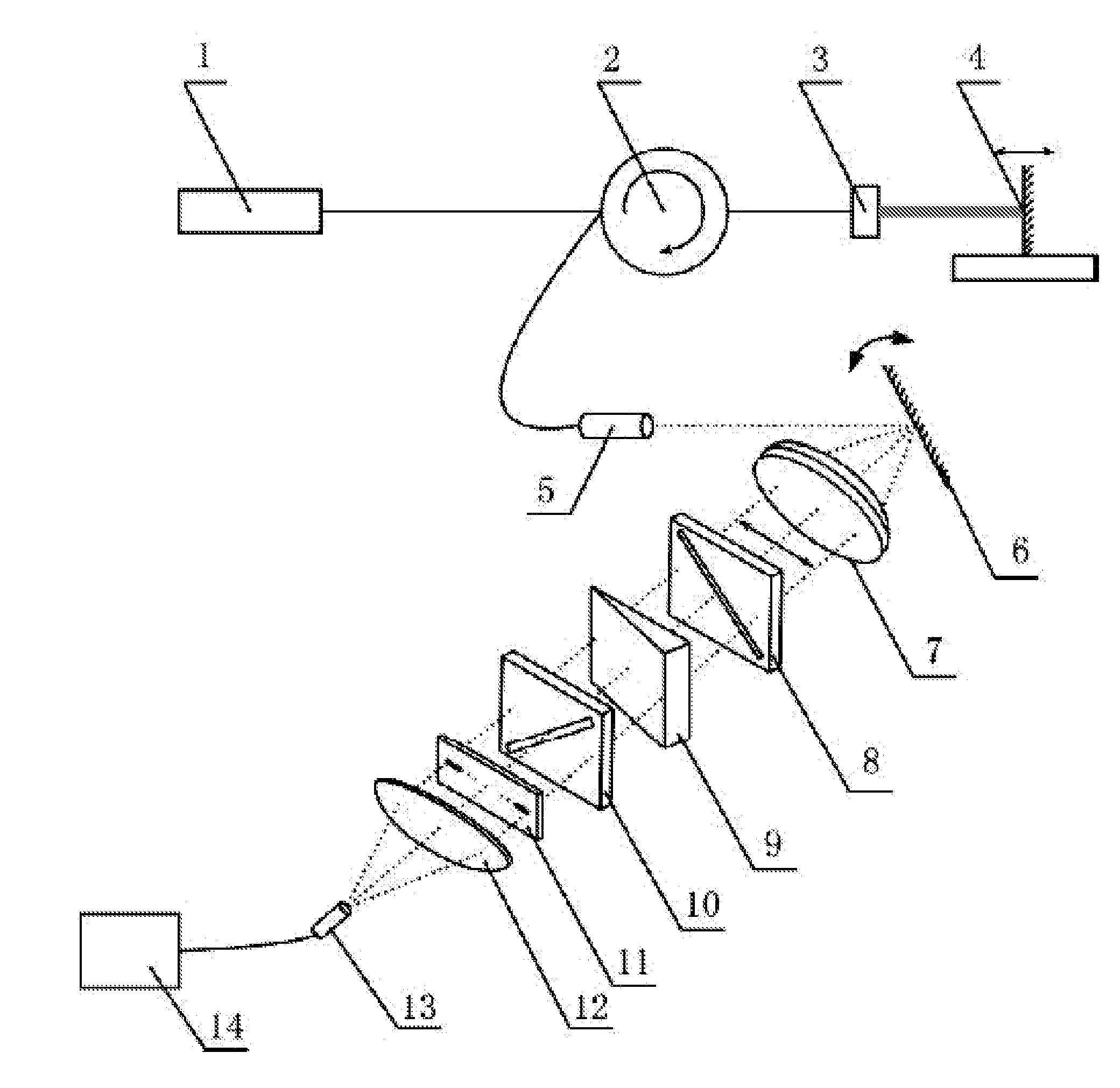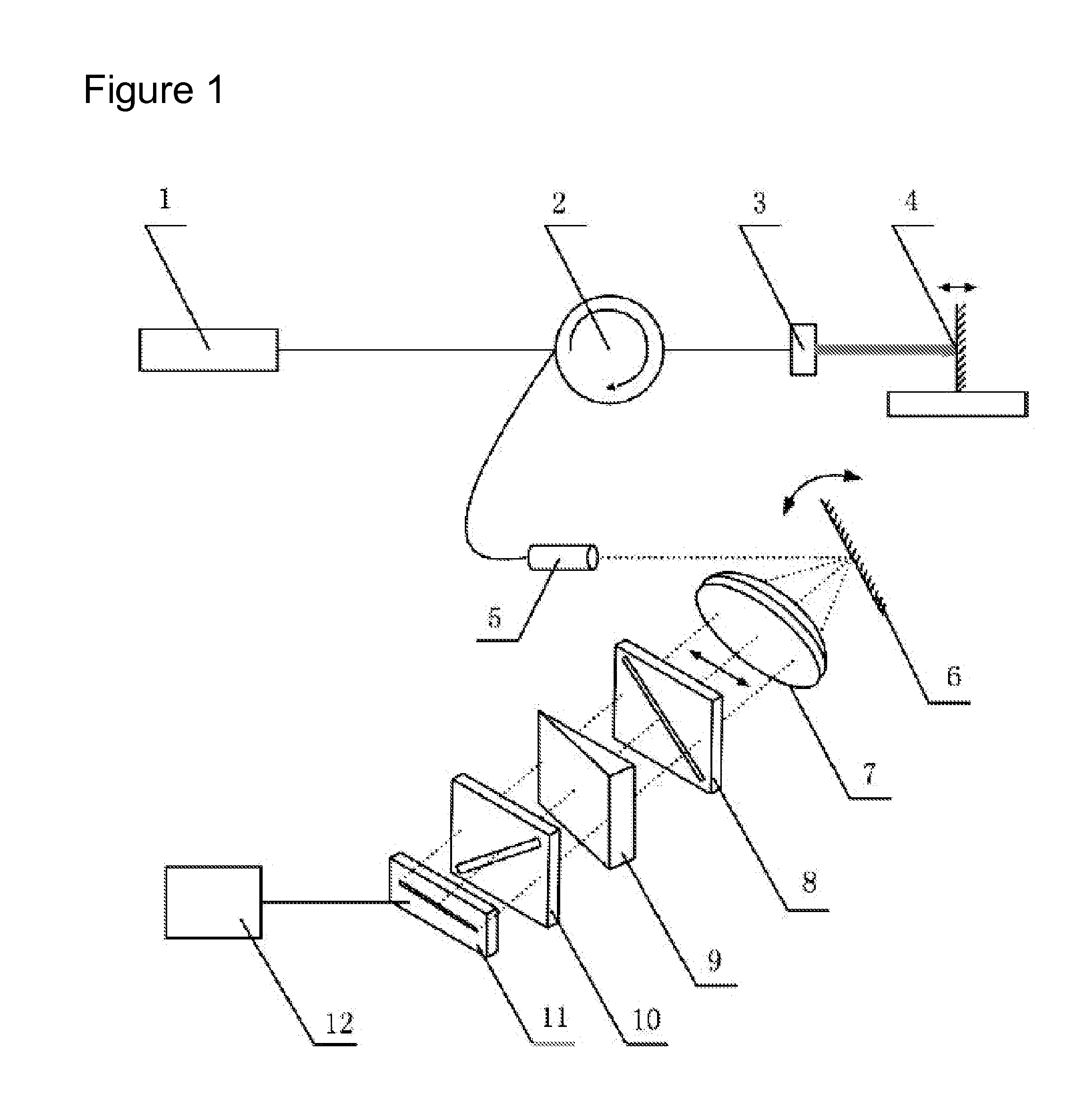Swing-style and high signal-to-noise ratio demodulation devices and corresponding demodulation method for the measurement of low coherence interference displacement
- Summary
- Abstract
- Description
- Claims
- Application Information
AI Technical Summary
Benefits of technology
Problems solved by technology
Method used
Image
Examples
embodiment 1
The First Swing-Style and High Signal-to-Noise Ratio Low Coherence Interference Demodulation Device for the Measurement of Displacement
[0023]As shown in FIG. 1, the light from the broadband light source 1 passes through the optical circulator 2 and arrives at the GRIN lens 3.
[0024]Part of the light is reflected by the coated end surface of the GRIN lens 3, and the other part goes to the fixed mirror 4 installed on the test object. The two reflected light beams later are combined into one beam by optical fiber.
[0025]After passing through the optical circulator 2, part of the reflected light travels to collimating device 5 and turns into a thin light beam. The thin light beam is reflected by the rotating mirror 6 and travels through the f-θ lens 7, in which the reflection point of the rotating mirror 6 coincides with the focus of the f-θ lens 7.
[0026]By swinging the rotating mirror 6, the thin beam scans along the longitudinal direction of the narrow strip shaped birefringent wedge 9....
embodiment 2
The Second Swing-Style and High Signal-to-Noise Ratio Low Coherence Demodulation Device for the Measurement of Interference Displacement
[0029]As shown in FIG. 2, the light from the broadband light source 1 passes through the optical circulator 2 and arrives at the GRIN lens 3.
[0030]Part of the light is reflected by the coated end surface of the GRIN lens 3, and the other part goes to the fixed mirror 4 installed on the test object. The two reflected light beams later are combined into one beam by optical fiber.
[0031]After passing through the optical circulator 2, part of the reflected light travels to collimating device 5 and turns into a thin light beam. The thin light beam is reflected by the rotating mirror 6 and travels through the f-θ lens 7, in which the reflection point of the rotating mirror 6 coincides with the focus of the f-θ lens 7.
[0032]By swinging the rotating mirror 6, the thin beam scans along the longitudinal direction of the narrow strip shaped birefringent wedge 9...
embodiment 3
The Demodulation Method of the Swing-Style and High Signal-to-Noise Ratio Low Coherence Interference Demodulation Devices for the Measurement of Displacement
[0037]The method of the low coherence interference demodulation device for the measurement of displacement shown in Embodiment 1 can be described as follows.
[0038]As shown in FIG. 1, light from the broadband source light 1 passes the optical circulator 2 to the GRIN lens 3. One part of the light is reflected by the coated end surface of the GRIN lens 3. The other part of the light passes the lens and arrives the reflection mirror 4 fixed on the test object. These reflected lights are coupled into optical fiber. There is an optical path difference ds between lights reflected from the coated end surface of the GRIN lens and that from the fixed mirror on the test object, where ds equals twofold of the distance between the GRIN lens 3 and fixed mirror 4.
[0039]As shown in FIG. 3, the two reflected lights form a thin light beam, after...
PUM
 Login to View More
Login to View More Abstract
Description
Claims
Application Information
 Login to View More
Login to View More - R&D
- Intellectual Property
- Life Sciences
- Materials
- Tech Scout
- Unparalleled Data Quality
- Higher Quality Content
- 60% Fewer Hallucinations
Browse by: Latest US Patents, China's latest patents, Technical Efficacy Thesaurus, Application Domain, Technology Topic, Popular Technical Reports.
© 2025 PatSnap. All rights reserved.Legal|Privacy policy|Modern Slavery Act Transparency Statement|Sitemap|About US| Contact US: help@patsnap.com



